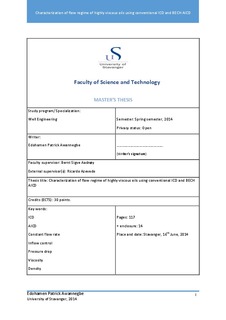| dc.description.abstract | Horizontal wells are currently very common for oil production, because they can increase its efficiency. An offshore platform for instance, may have several wells all aiming to produce from a common reservoir. In addition, each well can produce more oil being in contact with a larger part of the reservoir rock. However, long horizontal wells are subject to water or gas coning. These fluids exist naturally in the reservoir, or are injected into it to increase pressure and oil production. Due to their greater mobility under high pressure differences which are common in wells of this caliber, they end up going through the oil layer and reaching the wellbore before the oil, thereby forming these cones. To prevent this, there are several types of passive Inflow Control Devices (ICD’s) that can be placed along the horizontal part of the well which function by restricting its flow. Another important aspect here is that the production rates are normally higher at the heel of the well than at the toe. This is because the closer the fluid comes to the heel, the smaller the pressure it will face. One way to eliminate this issue is to simply make more perforations in the production tubing near the toe and decreasing the same near the heel.
Similarly, when using ICD’s they usually provide different pressure drops, depending on their distances to the heel. In general they work very well and are very reliable, during the early stages of production. The problem is that, as the reservoir is depleted, the flow rate decreases and flow regimes change, which often comes to cause cones again, sometimes near other parts of the well. Besides that, the best possible production will no longer be reached. There are some devices in the market that can autonomously avoid water or gas inside the tubing, interrupting the flow when necessary. However, they cannot adjust the flow rates according to depletion, nor avoid the formation of cones. Currently, there is one type of Autonomous Inflow Control Device (AICD) called the BECH AICD patented by Prof. Aadnøy of the University of Stavanger who also happens to be the supervisor of this thesis work – that can do that. Experimentally, it would be demonstrated that constant flow throughout the life of an oil field, and along the well, can be achieved by incorporating the mentioned patent into the down hole completion equipment. This can eliminate the cones, thereby making the production more stable and increasing the final/cumulative oil recovery. Other possible uses for this device are also stated at a later stage of this report. The experimental results obtained points to the fact that it can be used also for injection wells or in any well operation where constant flow is needed. They are designed as stand-alone robust devices to withstand the adverse operating conditions of a well.
However, ICDs have mostly been used for light oils. For fluid compositions having low viscosities, the flow is not dependent on viscosity but only on the density of the flowing fluid. Therefore when fluid properties change from light oil to water, the flow rate reduces according to the square root of the density ratio between oil and water as would be demonstrated in Chapter 5 of this report. Highly viscous oils occasionally have a density approaching that of water, often with a negligible density contrast. The transition from turbulent to laminar flow occurs earlier, and viscous pressure drops may become more significant (i.e. the pressure drop seen in the ICD nozzle becomes governed by viscosity which is highly sensitive to changes in temperature and pressure).
In the forgoing thesis report, an experimental setup is proposed where fluids of various viscosities and densities are flow-tested. Correlations would be established to enable accurate definition of the behavior of passive inflow control systems in relation to highly viscous oils or highly viscous oil fields. Seating at the center of this experimental study is the introduction of a BECH company Autonomous Inflow Control Device patented by Prof. Aadnøy of the University of Stavanger. This would serve to illustrate the unique benefits of this patent in that it is able to maintain a constant flow rate through its nozzle irrespective of pressure variation. A detailed presentation of flow regime investigation using the Bernoulli model as a reference point also forms an important aspect of this thesis. | nb_NO |

